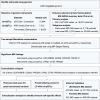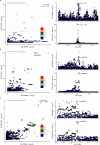Integrative multi-omics analysis identifies genetically supported druggable targets and immune cell specificity for myasthenia gravis
- PMID: 38521921
- PMCID: PMC10960998
- DOI: 10.1186/s12967-024-04994-2
Integrative multi-omics analysis identifies genetically supported druggable targets and immune cell specificity for myasthenia gravis
Abstract
Background: Myasthenia gravis (MG) is a chronic autoimmune disorder characterized by fluctuating muscle weakness. Despite the availability of established therapies, the management of MG symptoms remains suboptimal, partially attributed to lack of efficacy or intolerable side-effects. Therefore, new effective drugs are warranted for treatment of MG.
Methods: By employing an analytical framework that combines Mendelian randomization (MR) and colocalization analysis, we estimate the causal effects of blood druggable expression quantitative trait loci (eQTLs) and protein quantitative trait loci (pQTLs) on the susceptibility of MG. We subsequently investigated whether potential genetic effects exhibit cell-type specificity by utilizing genetic colocalization analysis to assess the interplay between immune-cell-specific eQTLs and MG risk.
Results: We identified significant MR results for four genes (CDC42BPB, CD226, PRSS36, and TNFSF12) using cis-eQTL genetic instruments and three proteins (CTSH, PRSS8, and CPN2) using cis-pQTL genetic instruments. Six of these loci demonstrated evidence of colocalization with MG susceptibility (posterior probability > 0.80). We next undertook genetic colocalization to investigate cell-type-specific effects at these loci. Notably, we identified robust evidence of colocalization, with a posterior probability of 0.854, linking CTSH expression in TH2 cells and MG risk.
Conclusions: This study provides crucial insights into the genetic and molecular factors associated with MG susceptibility, singling out CTSH as a potential candidate for in-depth investigation and clinical consideration. It additionally sheds light on the immune-cell regulatory mechanisms related to the disease. However, further research is imperative to validate these targets and evaluate their feasibility for drug development.
Keywords: Actionable druggable genome; Cell-type specificity; Genetic colocalization; Mendelian randomization; Myasthenia gravis.
© 2024. The Author(s).
Conflict of interest statement
The authors declare that the research was conducted in the absence of any commercial or financial relationships that could be construed as a potential competing interests.
Figures






Similar articles
-
Advances in the genetics of myasthenia gravis: insights from cutting-edge neuroscience research.Front Med (Lausanne). 2025 Jan 7;11:1508422. doi: 10.3389/fmed.2024.1508422. eCollection 2024. Front Med (Lausanne). 2025. PMID: 39845831 Free PMC article. Review.
-
Mendelian randomization and colocalization analysis reveal novel drug targets for myasthenia gravis.Hum Genomics. 2024 Apr 24;18(1):43. doi: 10.1186/s40246-024-00607-7. Hum Genomics. 2024. PMID: 38659056 Free PMC article.
-
A multi-omics and mediation-based genetic screening approach identifies STX4 as a key link between epigenetic regulation, immune cells, and childhood asthma.Clin Epigenetics. 2025 Jun 13;17(1):101. doi: 10.1186/s13148-025-01908-x. Clin Epigenetics. 2025. PMID: 40514687 Free PMC article.
-
Mendelian randomization analysis identifies druggable genes and drugs repurposing for chronic obstructive pulmonary disease.Front Cell Infect Microbiol. 2024 Apr 10;14:1386506. doi: 10.3389/fcimb.2024.1386506. eCollection 2024. Front Cell Infect Microbiol. 2024. PMID: 38660492 Free PMC article.
-
Multi-omics Mendelian randomization integrating GWAS, eQTL and pQTL data revealed GSTM4 as a potential drug target for migraine.J Headache Pain. 2024 Jul 22;25(1):117. doi: 10.1186/s10194-024-01828-w. J Headache Pain. 2024. PMID: 39039470 Free PMC article.
Cited by
-
Systematic Druggable-Proteome-Wide Mendelian Randomization Identifies Potential Therapeutic Targets for Allergic Conjunctivitis.Transl Vis Sci Technol. 2025 Jul 1;14(7):6. doi: 10.1167/tvst.14.7.6. Transl Vis Sci Technol. 2025. PMID: 40622200 Free PMC article.
-
Systematic druggable genome-wide Mendelian randomization identifies therapeutic targets for osteoporosis.Osteoporos Sarcopenia. 2025 Jun;11(2):57-64. doi: 10.1016/j.afos.2025.06.001. Epub 2025 Jun 7. Osteoporos Sarcopenia. 2025. PMID: 40677778 Free PMC article.
-
Role of circulating inflammatory protein in the development of diabetic renal complications: proteome-wide Mendelian randomization and colocalization analyses.Front Endocrinol (Lausanne). 2024 Jul 8;15:1406442. doi: 10.3389/fendo.2024.1406442. eCollection 2024. Front Endocrinol (Lausanne). 2024. PMID: 39040677 Free PMC article.
-
Genetic prioritisation of candidate drug targets for glaucoma through multi-trait and multi-omics integration.Eye Vis (Lond). 2025 Jul 10;12(1):26. doi: 10.1186/s40662-025-00442-4. Eye Vis (Lond). 2025. PMID: 40635100 Free PMC article.
-
Advances in the genetics of myasthenia gravis: insights from cutting-edge neuroscience research.Front Med (Lausanne). 2025 Jan 7;11:1508422. doi: 10.3389/fmed.2024.1508422. eCollection 2024. Front Med (Lausanne). 2025. PMID: 39845831 Free PMC article. Review.
References
Publication types
MeSH terms
Grants and funding
- 2021YFA1101403/National Key Research and Development Program of China
- 82090043/National Natural Science Foundation of China
- 81825008/National Natural Science Foundation of China
- Beijing Medical Research 2021-8/Pilot Project for Public Welfare Development and Reform of Beijing-affiliated Medical Research Institutes
- BPHR20220112/Project of Construction and Support for high-level Innovative Teams of Beijing Municipal Institutions
LinkOut - more resources
Full Text Sources
Medical
Miscellaneous

